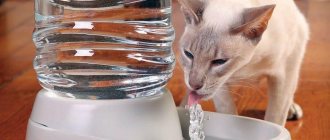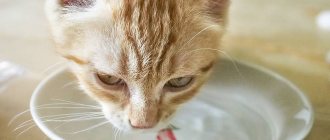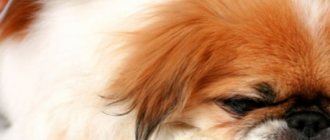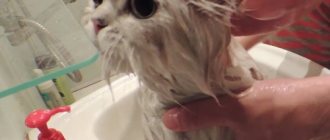The role of water in the dog's body
The dog does not drink water.
There is no particular need to explain why the dog needs water. Liquid is much more important for the body of a living creature than food. Even slight dehydration can lead to unpleasant consequences. Water is necessary for the functioning of the circulatory and digestive systems. The liquid also helps remove toxins from the body.
The amount of fluid consumed (norm) depends on the age, weight of the animal, and the weather. For example, in hot weather a dog should drink much more than if it is cool outside.
Important! If the dog lives in his own house, you should pay attention to whether he eats snow in winter. This method helps quench thirst, but is not useful.
What kind of water can you give your dog?
In order for the pet to be healthy and cheerful, when it comes to drinking, owners must follow the following rules:
- The liquid must always be clean. Dirt quickly collects and accumulates in open containers, so a person must clean and change the water in the drinking bowl.
- The fluid should be changed at least 2 times a day.
- The liquid should be at room temperature.
- The animal should always have access to clean water. Especially if your pet’s diet consists of dry food.
The water must be clean
Course for correction?
The “Springs of the Leningrad Region” project has been operating in the region for a long time, within the framework of which 375 socially significant springs were studied. More than half were contaminated, although people regularly took drinking water from them. This year, the project “Springs of the Leningrad Region” was transformed into a new format - “Clean Springs - Healthy Baltic”, won a presidential grant, and now, perhaps, will organize a larger-scale study of the region’s water bodies. The mechanism is as follows: experts, together with residents, examine the quality of water in local sources and plot the data on a public monitoring map. By the way, as part of the project, they have already created a map of springs in the Leningrad region, on which you can see how clean the water source is near your home right now.
Now specialists are recruiting a team to work with - anyone can join the project. Residents of the Leningrad region are also recommended to address environmental problems to regional public organizations - send photographs of violations, their description and coordinates. The same can be advised to their neighbors in St. Petersburg.
Angela Novoseltseva
Rosbalt presents the project “Frankly About Garbage!”, designed to remind you that the problem of proper waste disposal concerns any of us, and everyone can contribute to its solution. And the quality of our life tomorrow will depend on what answers we find today.
What kind of water should you not give to your dog?
First of all, you should remember that you should not give your animal dirty water, and this also applies to technical fluid, even if it has been purified. Water should not contain harmful elements or chemicals.
In addition, it is forbidden to give your pet rainwater from a puddle or drain. Do not forget that in this case a large number of harmful microbes penetrate into the dog’s body.
Important! If your pet begins to show interest in liquid from the toilet, this should also be stopped.
Incineration of sludge
The main problem with water in the Northern capital is that, despite the seemingly high-quality analysis that Vodokanal reports, it is still not checked according to all parameters.
Thus, the order of the Government of the Russian Federation dated July 8, 2015 N1316-r provides a complete list of pollutants that must be controlled in water bodies. This list includes 249 chemicals, organic pollutants, microorganisms, and radioactive isotopes. How about controls water only by 111 indicators, and the amount of chemicals is even less.
6868
In St. Petersburg - to burn?
“If you do a full analysis, it may turn out that the water is not suitable for drinking,” Gordyshevsky is sure. According to him, among the substances remaining in the “gray zone” are biphenyls, dioxins and other persistent compounds, which, according to the ecologist, cannot but be in the water, given the level of pollution of St. Petersburg soils.
So, in 2021, according to Rospotrebnadzor, St. Petersburg was among the top three regions of Russia with the dirtiest soil. Almost 30% of soil samples taken in the city did not meet hygiene standards. In November last year, the environmental management committee conducted another study - out of 128 soil samples in 8 districts of St. Petersburg, only 11 turned out to be non-hazardous. In the rest, excess concentrations of copper, cadmium, zinc, lead, benzopyrene and nickel were found.
“And this is not surprising: we remember that St. Petersburg is the only city in Russia where sludge sludge from urban wastewater is burned? And they contain the entire periodic table. Despite the filters, a huge amount of harmful substances enters the atmosphere and, according to the law of gravity, settles on the ground and in the water,” notes the ecologist.
5227
Coronavirus from the tap?
By the way, Vodokanal specialists say that the gases coming out of the sewage sludge incineration plant at the South-Western wastewater treatment plant are controlled by snails. However, Gordyshevsky calls the organization’s entire biomonitoring “pure propaganda and PR of a monopolist who has no competitors in the city.”
“Biomonitoring with crayfish and snails? Tricks! These are incorrect biological models, any doctor will say that protozoa cannot be compared with the human body, stupidity and profanity. Why are drugs developed on mice and not snails? Why on primates? Protozoa do not immediately react to the effects of the same dioxins, and humans do not react either - the most dangerous substances in water have neither smell nor taste. It takes years for a person to get sick, this is a cumulative effect. How long does a snail or crayfish live?” - Gordyshevsky asks.
The same problem, according to the ecologist, can easily be extrapolated to the Leningrad region - the neighboring region involuntarily falls under the influence of Vodokanal’s “incinerators”, harmful substances are carried by the “wind rose”. There is a way out - for example, the transition from combustion technology to the digestion of sludge as safer for the environment. However, Vodokanal does not yet like this alternative, and the organization is preparing to purchase new equipment for sludge incineration.
How much should a dog drink per day?
As already mentioned, the amount of fluid consumed directly depends on the weight of the pet. In addition, the age of the dog also matters. The indicators will be as follows:
- For puppies, there is at least 100 ml per 1 kilogram of weight. water.
- For an adult dog 1 kg. weight norm is 50 ml.
There is another way to calculate the minimum and maximum values. To start, you will also need the weight of the animal, for example 25 kg. To get the minimum value, the weight is multiplied by 20 (20*25=500), to get the maximum value, the weight is multiplied by 70 (70*25=1750).
The average is calculated using the following formula: max. + min./2.. (500+1750)/2 = 1125 ml. This is exactly how much a dog should consume per day.
Important! It must be remembered that in the summer, during the heat, the body needs more fluid. It is best to change the water 3 times a day during such periods.
The animal needs a certain amount of fluid per day
Signs of exhaustion and illness
If a dog refuses water, sooner or later this will lead to obvious signs of dehydration and exhaustion. You can check the condition of the animal in several ways:
- Pull the skin at the withers and then release. In normal condition, the fur and skin quickly return to their original place. A slow reaction indicates a lack of fluid.
- Check the condition of your gums. If everything is normal, they have a reddish-pink tint. When pressed, the gums turn white, but then quickly return to their normal color.
In addition, dehydration is accompanied by other symptoms:
- refusal to eat;
- lethargy, drowsiness;
- dull look, the iris becomes faded;
- redness of the whites;
- the dog stops being active and lies down more;
- The dog begins to urinate less often and does it with difficulty.
Reasons why a dog doesn't drink water
Why doesn't the dog drink water? The reasons may be different:
- Dirty dishes are on display or the liquid in the bowl is dirty. As already mentioned, the animal’s dishes should also be cleaned regularly (at least 1-2 times a day). Otherwise, dirt and drool will quickly accumulate in the bowl and the water itself.
- There is damage in the oral cavity. This could be the tongue, the gums themselves, or the teeth. In any case, it will simply be painful for your pet to drink.
- Diseases of the respiratory system. A cold or laryngitis causes swelling in the throat and makes swallowing painful.
- The dog is pregnant. At certain times, refusal of liquid will be normal.
- The animal has not yet recovered from castration or sterilization.
- Diseases. Ailments can be very different, including cancer, problems with the genitourinary system, poisoning, and so on.
Important! If you are not sure why your dog is not drinking water, it is best to take the dog to the veterinarian. You should not put off going to the doctor; early diagnosis will help prevent unpleasant consequences.
Refusal to drink water can happen for a variety of reasons.
Why does a dog refuse water but eat?
The cat does not drink water at all: what to do, why
There are many reasons why a dog doesn't drink enough water. The main ones are as follows:
- The water in the bowl is dirty, dogs will not drink if they feel it is stale. You need to change the water daily and wash the bowl well. In summer, it is recommended to add fresh liquid every three hours.
- The animal may not like its bowl, for example, the smell.
- Inflammatory processes in the oral cavity, which make it painful for your pet to drink.
- Incorrect nutrition.
- Viral diseases in which the dog completely loses its appetite.
Often, owners of pregnant and old dogs are faced with water refusal. This phenomenon is also observed in pets who suffer from diabetes, malignant tumors and renal failure.
Refusal of water may indicate poor health of the pet
If your puppy doesn't drink water
Why does my puppy drink little water? This question also worries pet owners. It all depends on the situation: if the dog continues to eat well, then there is most likely nothing to worry about. Most likely, the baby gets enough fluid from food (if the food is natural and not store-bought).
In addition, the puppy may not yet know how to lap. You cannot teach this on your own. In some cases, the dog has to be bottled.
However, there may be other, less harmless reasons:
- poisoning;
- entry of a foreign object into the body;
- disruption of internal organs;
- intestinal obstruction and so on.
Consequences of not drinking
In general, a lack of fluid quickly has a negative effect on the body. The consequences may be as follows:
- lethargy, lethargy;
- decreased tone;
- joint problems;
- disruption of internal organs;
- deterioration of metabolism;
- poisoning by toxins that are no longer excreted;
- development of chronic diseases.
Important! If you delay in solving the problem, your pet’s condition will only worsen. As a result, surgery may be required or the animal will simply die.
Dehydration and exhaustion
How to train a dog to drink water
It is simply impossible to force a dog to drink water. The owner can only create the most suitable conditions so that the dog himself wants to drink. Some tips:
- Walk more with your pet and do active physical exercise.
- Provide food according to a specific schedule.
- Clean drinking water should always be available to the animal.
- It is best to try not to scold or irritate your pet again. Stress also negatively affects pets.
Why does a dog refuse to drink?
Dogs must maintain adequate hydration status
, so a dog's refusal to drink water is a cause for concern. You should expect your pet to drink water freely and enthusiastically several times a day.
- If your dog doesn't drink for a day or more and turns his head away when offered water, there is likely a health problem.
- Animal aging
- Polluted water
- Dehydration
- Urinary tract infection
- Oral diseases or injuries
- Water is a basic requirement for maintaining health.
Dogs that don't drink for more than one day
, may become dehydrated, which is a dangerous condition that may require veterinary attention. Why does refusal to drink occur in sick dogs? Drinking water is the cornerstone of any dog's health, and disruption to normal drinking patterns can indicate a wide range of problems. It is not normal for a pet to refuse to drink.
Water for a decorative dog
The physical condition of toy dogs is more fragile than that of large dogs. As for drinking them, the owner should remember the following additional rules:
- Puppies need to be given water every 2 hours. They should drink in small portions.
- If the dog drains the bowl immediately after active play, you should not pour new liquid at the same minute. You need to wait a little.
- For a long walk, be sure to take a water bottle.
- Particular attention should be paid to the amount of fluid you drink during hot periods.
The issue of drinking water for pets is very important. The owner must monitor the quantity and quality of the liquid, because the condition and physical strength of the four-legged friend depend on this.
Additional rules for providing water for a decorative dog
- 1. Puppies should drink small amounts every two hours. After they drink, they should definitely be praised.
- 2. If, after intense play, the dog immediately drinks all the water in his search, do not pour a new portion immediately. Wait a little.
- 3. If you are planning a long walk with your dog with intense play, be sure to take water with you.
- 4. Monitor how much water your baby drinks especially closely on hot days.
4 recipes for homemade rinses for decorative dogs with allergies
Treatment of skin itching in dogs of decorative breeds with polyunsaturated fatty acids











